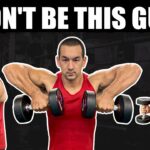Is your workout routine in dire need of a mix-up? Are your bench press results plateauing? If so, it’s time to power past your rut by introducing some new moves into your strength training plan. While this excellent exercise can yield some incredibly impressive strength gains, it’s not always a good idea to stick to it exclusively.
In fact, spicing up your chest workout regimen with some effective alternatives can help you build upon your existing strength and challenge your muscles in new ways. The more you keep your workouts fresh and challenging, the easier it will be to make some serious progress in your fitness journey.
10 Bench Press Alternatives to Add Variety in Your Routine
When you take a look at the bench press alternative options, you’ll notice quite a few exercises that can help you progress with your chest training routine. This variety is inherently beneficial because it helps work different muscles and achieve a range of fitness goals.
Dumbbell Chest Press
Now, you might be thinking – isn’t this the same exercise as the bench press? Isn’t the only difference swapping out the barbell for a pair of dumbbells? While it’s true that this move is rather similar to the bench press, there are a few subtle differences.
The primary difference between these two exercises lies in stability. When you use a barbell to perform the bench press, it’s naturally easier to maintain balance than when using two separate dumbbells. This means that with the dumbbell chest press, you’re engaging more secondary muscles to help stabilize the movement.
When you have a separate weight plate in each hand, they’re not relying on each other to keep it balanced – meaning you’re engaging more muscles with each rep. In fact, there’s quite a bit of research regarding strength performance and muscle activation with the use of different equipment. If you’re looking at the dumbbell and barbell bench presses in particular, the former has been found to recruit more muscle fibers in certain areas.
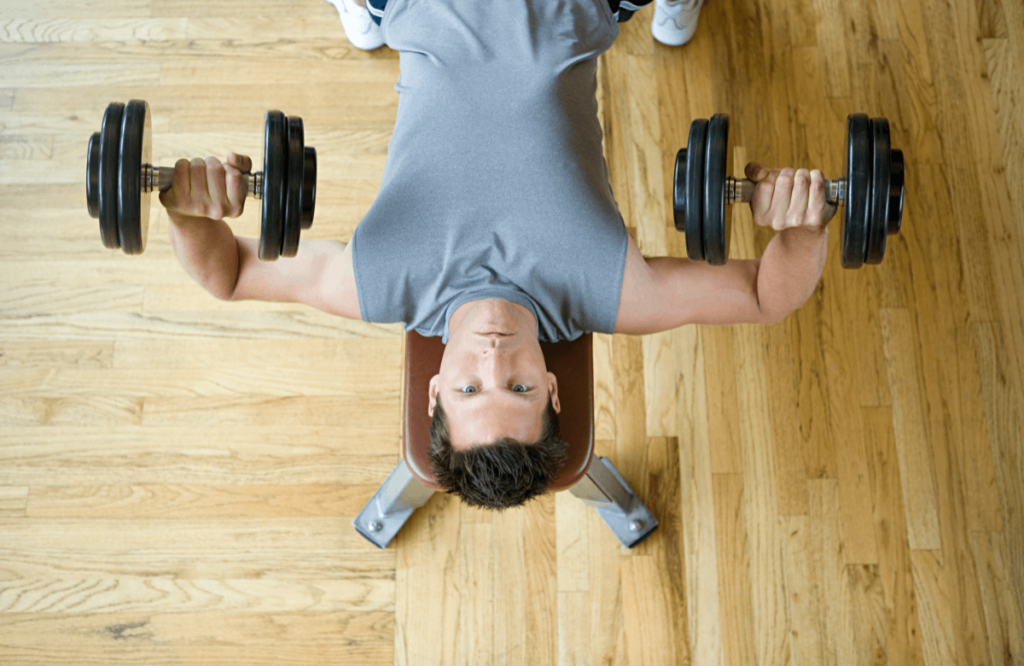
Another reason why the dumbbell chest press offers a more impactful workout is that it provides greater horizontal shoulder adduction. This refers to the movement of the shoulder back and inwards – something that can be difficult to achieve with a barbell. When you’re pressing a singular barbell, your shoulders remain relatively stationary – but with dumbbells, you can move the weights more freely.
When you have these inward-outward movements of the shoulder, you’re not only actively engaging more muscles – but you’re also working on improving joint and shoulder health. This is especially beneficial if you have any pre-existing injuries or a history of shoulder instability or other issues.
Finally, you can also use this exercise for unilateral training – meaning you can go with one arm at a time. When you use heavier weights, performing the exercise one side at a time can help you focus on maintaining form and balance while also helping to even out any strength imbalances you may have between each arm.
Get into a comfortable position by lying flat on your back on a bench. Keep your feet firmly planted on the floor and hold on to a barbell in each hand at chest level. Start extending your arms over your chest until they’re directly over your shoulders at the very top.
Once your arms are fully extended, slowly lower the weight back down to your chest and repeat. The number of reps will vary based on your fitness goals and the weight you’re using, but the general recommendation is to start with 3-4 sets of 8-12 reps.
Push-Ups
While bench press workouts can be quite effective, performing simple bodyweight exercises like push-ups are some of the best alternatives to build strength and achieve great results. In fact, there’s scientific evidence that shows that muscle activity patterns don’t differ between the two forms of training despite there being obvious differences in the way each one is performed.
Plus, there’s a greater level of variation that can be achieved through push-ups. Not only can you alter your hand placement to hit different muscles, but you can also adjust the angles to target certain areas of your chest more effectively. For instance, a narrow grip push-up targets the triceps, while a wide grip focuses on the chest muscles.
To perform this exercise, do a plank and keep your hands a bit wider than shoulder-width. Gradually lower yourself down until your chest is just an inch away from the floor and then push back up to the starting position. Make sure to keep your abs and glutes contracted throughout the exercise to help engage your core muscles. If you’re feeling too much stress on your wrists, try altering your hand placement or using an elevated surface like a bench or step for added stability.
You could also use a resistance band when you get into a plank position to help increase the intensity of this exercise. To do this, simply loop a band around your back and hold each end with your hands, then perform the push-ups while maintaining tension on the band. As far as reps and sets go, start with 3-4 sets of 10-15 repetitions.
Incline Dumbbell Press
Another variation of the dumbbell press is the incline dumbbell press. This exercise targets your chest and shoulder muscles from a slightly different angle, allowing for greater stabilizing muscle activation. The slight incline means that your shoulder blades are slightly pulled back, allowing you to engage more of the chest muscles throughout each rep.
Start by lying on an incline bench. Have a dumbbell in each hand, extending your arms outward with your palms turned away from your body. Slowly lower the weights to chest level and then press back up to the starting position. Make sure to keep your core engaged throughout this exercise and avoid arching your back – as that can lead to potential injury.
Keep your elbows tucked in, as this will help you target the chest muscles more effectively. As with any other exercise, reps and sets will vary depending on your fitness goals. Aim for 3-4 sets of 8-12 reps for a solid chest workout.
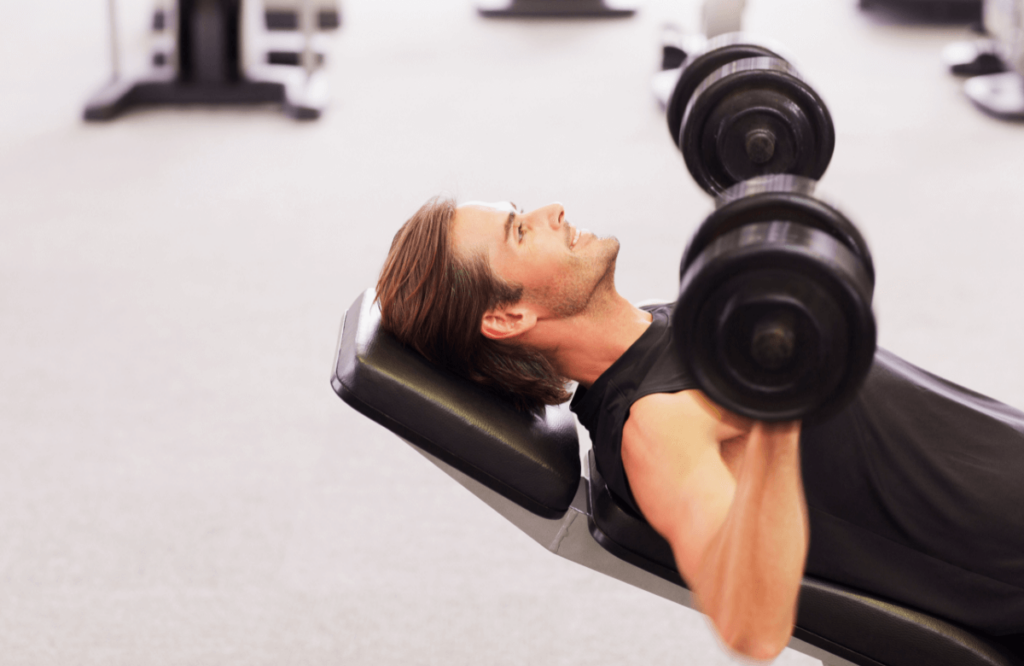
You can also perform this same movement on a machine at the gym. Instead of using barbells, your machine is designed to provide a more stable environment, allowing you to target your chest muscles with greater precision. Adjust the seat height and incline level accordingly to accommodate your height and body type. This exercise can be a good starting point for beginners since it eliminates the need to balance the weight on your own.
Incline Barbell Bench
While the barbell bench press is typically done lying flat, it can also be performed in an incline position. This variation of the exercise targets your chest muscles from a slightly different angle and recruits more stabilizing muscle fibers than the regular flat bench press.
The idea here is to minimize shoulder strain while still targeting your chest muscles and improving overall strength. This can be particularly useful for people with shoulder injuries or instabilities, as it helps them to strengthen their chest without putting too much strain on the joints.
The starting position for this exercise involves lying back on an incline bench with a barbell in hand. Make sure to adjust the seat height accordingly and keep your feet firmly planted on the floor. Start by lowering the bar down to chest level, keeping your elbows tucked in as you do so. Then, press the barbell back up to the starting position and repeat.
As far as reps and sets go, start with 3-4 sets of 10-12 reps for the most effective results. Be sure to focus on the form and technique as you perform this exercise, as that’s what will help you achieve the desired results. And if it’s too much for you at any time, simply reduce the weight or modify the exercise according to your needs.
Butterfly Presses
This is a similar approach to the dumbbell fly but includes the use of a machine to help support the body and provide a more controlled range of motion. The upright position of the machine allows for greater stability while performing the exercise, making it easier to focus on squeezing your chest muscles in each rep.
To get your starting position ready, sit down on the machine and adjust the height accordingly. You should keep your feet flat on the floor and your back firmly pressed against the backrest. Once you’re comfortable, grab both handles with each hand and press them together until your arms are fully extended.
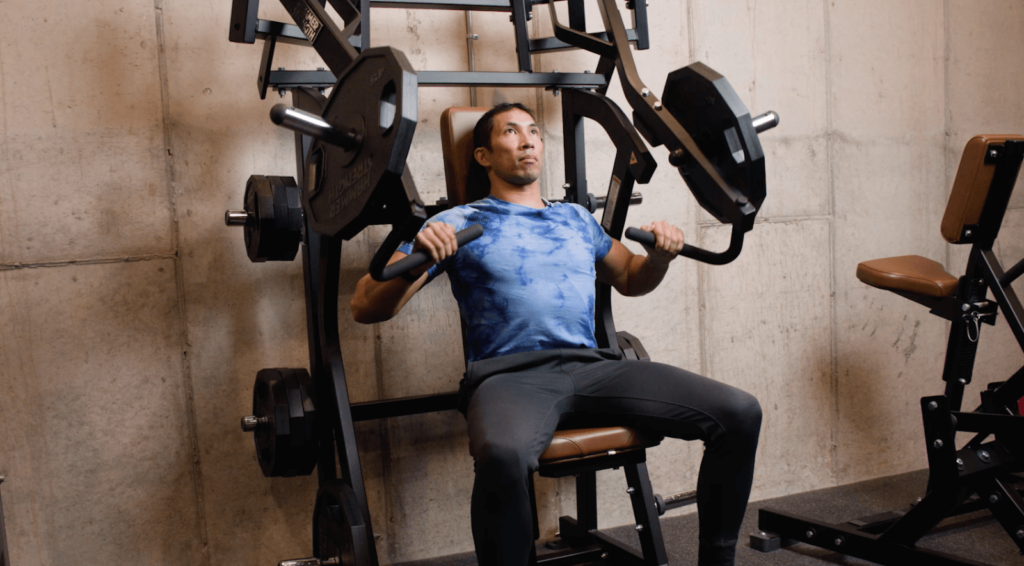
Slowly bring the handles together while keeping your elbows slightly bent and chest muscles engaged. Hold this position for a second before returning to the starting position. Be sure to keep your core engaged throughout this exercise and focus on squeezing your chest muscles in each rep. You can adjust the weight depending on your fitness goals and level of strength.
For best results, start with 3-4 sets of 10-12 reps and increase the weight as you progress. Also, make sure to keep your movements slow and controlled – don’t go too fast or jerk the weights around as that can lead to potential injuries.
Dumbbell Fly
The movement pattern of this particular exercise is similar to that of the regular bench press but with a bit more focus on the chest muscles. The dumbbell fly is most effective when done on a decline bench, as it allows you to contract your chest muscles even more as you press up.
Getting your dumbbells in position involves you holding them in each hand and lying back on the decline bench. Keep your hands extended on the side with the palms facing upwards and then, with control and a slight arch in your back, lift up the dumbbells until they meet at the top. Lower them down slowly to the starting position and repeat.
The goal here is to maintain your chest muscles in a contracted position throughout the entire movement. Of course, the movement itself is a bit more tricky when compared to the other exercises, but it will be worth the effort once you master the technique. As for reps and sets, aim for 3-4 sets of 8-10 repetitions.
Bodyweight Dips
Using your body weight to challenge and strengthen your chest muscles is an age-old exercise. Bodyweight dips can help you target your chest muscles effectively without having to use any weights or machines.
In the traditional sense, triceps dips or vertical dips involve your upper body supporting your entire weight. The setup of this exercise involves two parallel bars or handles on either side. Start by grabbing the handles with your palms facing away from you. While keeping your arms extended and your knees bent, gradually descend until your elbows form a 90-degree angle.
If you keep your back fully upright, you’ll put more emphasis on your triceps rather than your chest. If you effectively want to target your chest muscles, try slightly leaning forward and bringing your shoulder blades back. This will help you engage more of the chest muscles throughout each rep.
Another variation of this exercise is using a dip rack to perform Gironda Dips, named after the famous bodybuilder Vince Gironda. In this variation, you’ll need to keep your legs together and pull them out in front of you. Then, push your hips back, close to a suspended hip hinge to facilitate the movement. Next, flare your elbows at a considerable angle and tuck your chin to your chest as you go down.
This exercise is great for those who want to gain more upper body strength and size. It is a bit more challenging than traditional dips so you’ll need to have some pre-existing strength and knowledge of the correct form in order to perform them effectively.
Finally, standard bench dips are also easy to perform without a rack and can be done almost anywhere. All you need is a stable box, chair, or bench that can support your weight. Start by sitting on the bench and placing your hands on either side of it, with your palms facing down. Then, lift yourself up using your hands and extend your legs out so that they’re parallel to the ground.
Keep your torso upright and slowly lower yourself down until your elbows are at a 90-degree angle. Then press back up to the starting position and repeat for as many reps as you wish. Start with 3 sets of 15-20 reps and increase the intensity of the exercise over time.
Landmine Press
While there are plenty of landmine press variations available, the most basic and effective approach involves using a barbell and placing it into a landmine station (or any corner of a wall). Start by grabbing the barbell with one hand and your other hand on your hip for support. The goal is to use your upper body strength to press the barbell up explosively.
This exercise brings together strength and explosive power, making it incredibly beneficial for those who want to build a stronger upper body. You can also add a few weight plates if you’re looking for something more challenging.
Start by doing 3 sets of 8-10 reps and adjust the weight as your strength increases over time. Keep your movements stable and controlled – don’t rush through the exercise or jerk the weights around to avoid injury.
Medicine Ball Chest Pass
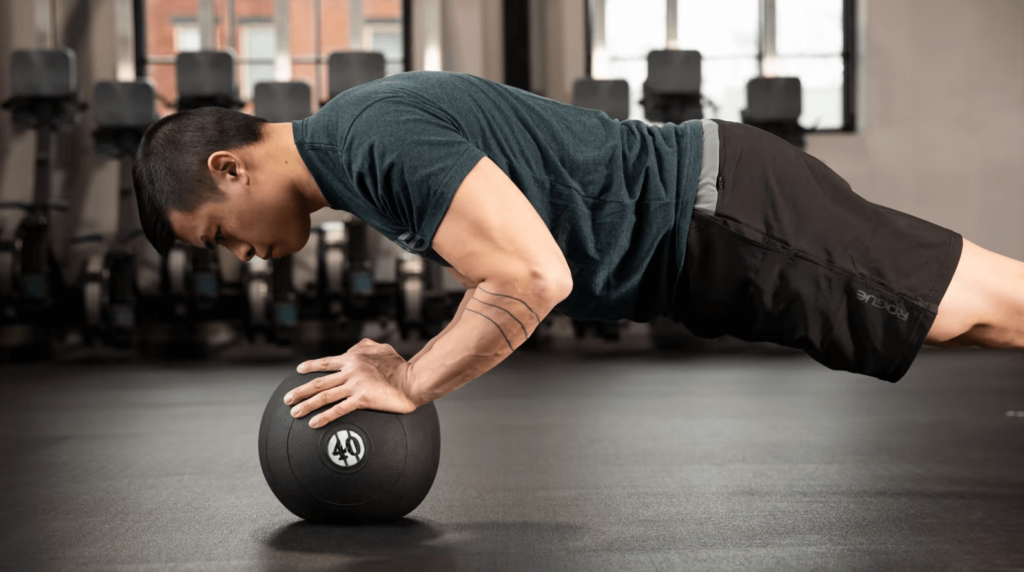
For slightly lighter weights and a more controlled exercise, the medicine ball chest pass is a great alternative to bench press workouts. A medicine ball is essentially a weighted ball made of rubber or leather and it comes in various sizes and weights. It’s designed to target your upper body (especially the chest muscles) and help you build more strength.
To perform this exercise, get into a standing position in front of a wall or partner (if the ball is heavy enough) and hold the medicine ball at chest level. Then, explosively press the ball forward and catch it when it reaches its peak.
Start with a lighter ball (5-10 pounds) and gradually increase the weight as you progress. Going straight in with a heavy weight can potentially result in sore muscles and/or injuries, especially if you haven’t trained for a longer time.
Cable Crossover Flys
To really engage your pectoral muscles and keep your shoulder joint at a safe angle, cable crossover flys can bring a balanced building routine. While you can certainly do this same movement with dumbbells from a wider range of angles, using cables ensures consistent resistance and force is applied throughout the exercise.
Plus, you can raise or lower the pulley system, depending on the muscles you want to target. This is inherently useful if you’re looking to specifically target certain areas of your chest, such as the lower or upper section.
Start by grabbing two cables with an overhand grip and step back until your arms are extended. Next, keep your elbows slightly bent and pull the cables towards each other in a slow and controlled manner. Make sure you don’t overextend your elbows as you press outwards – that could lead to shoulder pain over time.
At the end of each rep, squeeze your chest muscles together for an extra burn and then slowly release the tension and return to the starting position. You can lean forward or stagger your stance to target different parts of the chest. Start with 3 sets of 10-15 reps and adjust the weight accordingly.
FAQs:
How Can I Bench Press Without a Bench?
You can perform the traditional bench press on the floor if you don’t have access to a bench. You simply need to lie down on your back and do the same exercise as you would using a bench, just without any support from the bench itself.
What Makes a Bigger Chest?
Traditional bench presses, dip machine exercises, and cable crossover flys are all effective options for building primary muscle growth across the chest area. When you’re consistently performing these exercises with a high degree of intensity, you can begin seeing results in as little as 6-8 weeks.
What Is the Best Substitute for Bench Press?
There are several bench press alternatives that can help you target different parts of your chest muscles. Push-ups, dumbbell chest presses, butterfly presses, and incline barbell benching are all effective choices to get a full upper body workout without the need for a bench.














